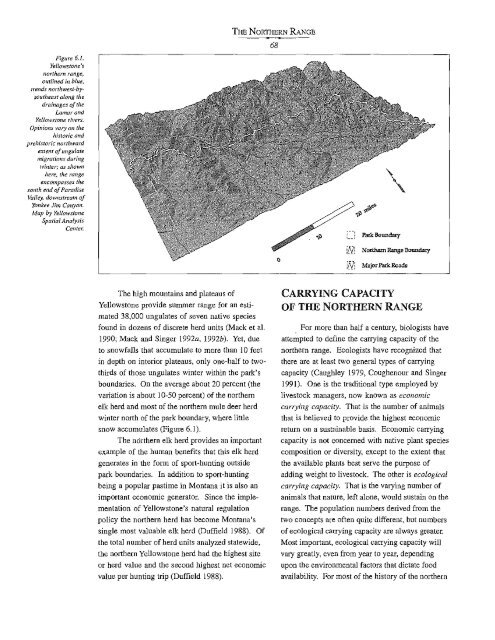Yellowstone's Northern Range - Greater Yellowstone Science ...
Yellowstone's Northern Range - Greater Yellowstone Science ...
Yellowstone's Northern Range - Greater Yellowstone Science ...
Create successful ePaper yourself
Turn your PDF publications into a flip-book with our unique Google optimized e-Paper software.
Figure 6.1.<br />
<strong><strong>Yellowstone</strong>'s</strong><br />
northern range,<br />
outlined in blue,<br />
trends northwest-bysoutheast<br />
along the<br />
drainages of the<br />
Lamar and<br />
<strong>Yellowstone</strong> rivers.<br />
Opinions vwyon the<br />
historic and<br />
prehistoric northward<br />
extent of ungulate<br />
migrations during<br />
winter; as shown<br />
here, the range<br />
encompasses the<br />
sOllth end of Paradise<br />
Valley, downstream of<br />
Yankee Jim Canyon.<br />
Map by <strong>Yellowstone</strong><br />
Spatial Anaiysis<br />
Centel:<br />
THE NORTHERN RANGE<br />
68<br />
\<br />
iN]<br />
fN;<br />
<strong>Northern</strong> <strong>Range</strong> Boundary<br />
Major Park Roads<br />
The high mountains and plateaus of<br />
<strong>Yellowstone</strong> provide summer range for an estimated<br />
38,000 ungulates of seven native species<br />
found in dozens of discrete herd units (Mack et al.<br />
1990; Mack and Singer 1992a, I 992b). Yet, due<br />
to snowfalls that accumulate to more than 10 feet<br />
in depth on interior plateaus, only one-half to twothirds<br />
of those ungulates winter within the park's<br />
boundaries. On the average about 20 percent (the<br />
variation is about 10-50 percent) of the northern<br />
elk herd and most of the northern mule deer herd<br />
winter north of the park boundary, where little<br />
snow accumulates (Figure 6.1).<br />
The Mrthern elk herd provides an important<br />
example of the human benefits that this elk herd<br />
generates in the form of sport-hunting outside<br />
park boundaries. In addition to sport-hunting<br />
being a popular pastime in Montana it is also an<br />
important economic generator. Since the implementation<br />
of <strong><strong>Yellowstone</strong>'s</strong> natural regulation<br />
policy the northern herd has become Montana's<br />
single most valuable elk herd (Duffield 1988). Of<br />
the total number of herd units analyzed statewide,<br />
the northern <strong>Yellowstone</strong> herd had the highest site<br />
or herd value and the second highest net economic<br />
value per hunting trip (Duffield 1988).<br />
CARRYING CAPACITY<br />
OF THE NORTHERN RANGE<br />
For more than half a century, biologists have<br />
attempted to define the carrying capacity of the<br />
northern range. Ecologists have recognized that<br />
there are at least two general types of carrying<br />
capacity (Caughley 1979, Coughenour and Singer<br />
1991). One is the traditional type employed by<br />
livestock managers, now known as economic<br />
carrying capacity. That is the number of animals<br />
that is believed to provide the highest economic<br />
return on a sustainable basis. Economic carrying<br />
capacity is not concerned with native plant species<br />
composition or diversity, except to the extent that<br />
the available plants best serve the purpose of<br />
adding weight to livestock. The other is ecological<br />
carrying capacity. That is the varying number of<br />
animals that nature, left alone, would sustain on the<br />
range. The population numbers derived from the<br />
two concepts are often quite different, but numbers<br />
of ecological carrying capacity are always greater.<br />
Most important, ecological carrying capacity will<br />
vary greatly, even from year to year, depending<br />
upon the environmental factors that dictate food<br />
availability. For most of the history of the northern















